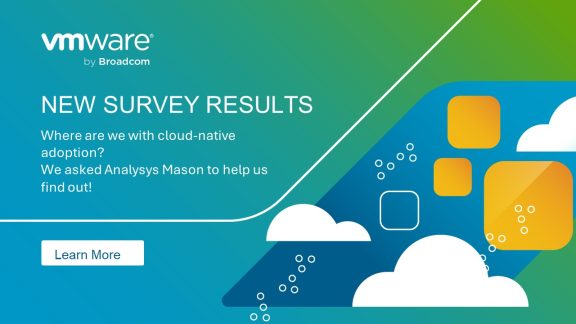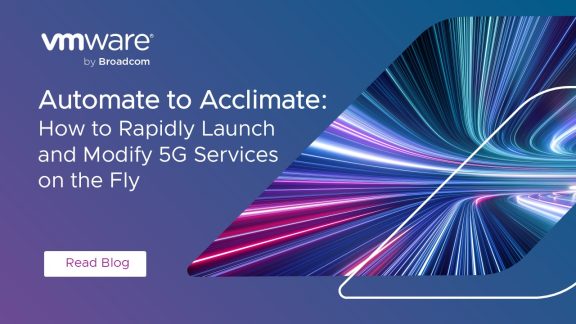If you follow the telecommunications space, it can seem like we’ve been talking about cloud transformation for years. Since the early days of 5G specifications planning, “cloudifying” telco networks was arguably the most consequential change to telco operations and business models. This transformation was always going to be a journey for communication service providers (CSPs), and no one expected it to happen overnight. Circa mid-2024 though, it’s fair to ask how much of the talk has translated into concrete results.
How far have the world’s CSPs come in their adoption of microservices architectures, horizontal cloud platforms, continuous integration/continuous delivery (CI/CD) frameworks, and other elements of cloud-native mobile core operations? What barriers still remain, and what are organizations doing about them? We decided to find out.
Earlier this year, VMware asked Analysys Mason to conduct a global survey of CSP cloud-native mobile core adoption and develop a formal index of cloud-native maturity. Following are some of the highlights.
Inside the Survey
Analysys Mason surveyed senior decision-makers at 75 operators worldwide whose organizations had either implemented cloud-native mobile cores or were planning to within the next three years. Respondents included executives from both mature and emerging markets, with a majority (55%) from Western Europe, North America, and developed Asia-Pacific nations. All organizations surveyed provide mobile network services, with the vast majority also providing fixed network services (95%) and managed information and communications technology to enterprise customers (83%). Most were larger operators, with 84% generating more than US$1 billion in annual revenue.
The biggest takeaway: we are still in early days of cloud-native transformation, and significant variation exists across operators and markets. While leading CSPs have made major strides with cloud-native mobile cores, both commercially and technically, laggards remain far behind. And across the board, operators continue to struggle with the complexity of cloud-native operations, as well a lack of mature automation and ecosystem support.
By some measures, many CSPs have accomplished a great deal—especially those with the most mature cloud-native implementations, whom Analysys Mason classifies as “index leaders.” For example, 48% of respondents say they currently use containers, and that figure should grow to 79% within the next year. The numbers for multi-vendor CI/CD pipelines look similar. But while these are important steps, they don’t necessarily imply full cloud-native operations.
Analysys Mason defined two criteria to consider an operator truly cloud-native: implementing a microservices architecture and using a horizontal cloud platform for network functions (NFs). By this definition, just 21% of operators have met the minimum threshold, and 39% have yet to complete either. If we raise the bar to encompass the full range of cloud-native attributes, no CSP can yet be considered truly cloud-native.
Looking ahead, the numbers get more encouraging. Within a year, 52% of CSPs will have met Analysys Mason’s minimum cloud-native requirements, and within three years, that figure should increase to 88%. Things look even more promising when focusing on index leaders—primarily, tier-1 operators in North America, China, India, and mature Asia-Pacific markets. These CSPs have made good progress on cloud-native mobile core implementations, both technically and commercially. In fact, among operators who meet minimum cloud-native requirements, 57% already support three or more commercial use cases. Their task now: scaling their deployments and introducing more automation.
Overcoming Barriers
Among the survey’s most encouraging findings, index leaders have created a successful template for overcoming internal barriers and advancing cloud-native deployments. These operators have developed the needed operational skills and have strong buy-in from C-level leadership, who view cloud-native core transformation as a key component in creating new services and revenue streams. In fact, among index leaders, 45% said that acquiring cloud-native capabilities was among their leadership’s top-three strategic priorities.
Unfortunately, even among leaders, external challenges—especially the lack of maturity in the cloud-native ecosystem—continue to hamper growth. These CSPs report that their success varies greatly depending on which NF vendor they’re working with. Nearly half (48%) said that their vendors’ mobile core NFs are not cloud-native enough, and about a third said the same about open-source standards and even 3GPP specifications themselves.
Across the board, the biggest barrier to mobile core maturity is a lack of automation. In fact, Analysys Mason found a major gap between operators’ perceptions of their level of automation versus their actual level, based on specific DevOps metrics like deployment frequency and average lead times for changes. On average, CSPs claim to have automated 45% of cloud infrastructure and 50% of mobile core NF lifecycle operational processes. By the analyst’s standards though, just a handful of leaders have automated more than 30% of their environment and none cracked 50%.
Even in these early stages, however, the most mature CSPs—and those already seeing the biggest benefits from cloud-native transformation—are the most automated. For example, index leaders are already using significant observability data to drive closed-loop automation. These leaders are also more mature in their ability to release new software updates. Among CSPs that meet minimum cloud-native requirements, 58% already deploy software updates on demand, and 33% deploy updates on a weekly or monthly basis.
Looking Ahead
What conclusions should we draw from this survey? First, there clearly remains a gap between the industry’s cloud-native aspirations and the current state of play. Many CSPs have significant work to do to reach their targets over the next three years. And even once operators have deployed cloud-native mobile cores, they will need to rapidly scale their deployments to start generating a return on investment.
Nevertheless, even in these early days, it’s already clear that the benefits of cloud-native mobile cores can be significant—especially for enabling new services and revenue streams. The most mature cloud-native operators already support multiple commercial use cases, including both consumer offerings like broadband fixed wireless access, and specialized enterprise use cases targeting industry, public safety, utilities, and more.
Indeed, the report’s most exciting finding might just be how committed industry leaders are to innovation. Consider proposals around exposing network APIs. Among operators at all maturity levels, 85% plan to monetize APIs within the next two years.
Clearly, much work remains to be done before we can say that telecom has truly passed the cloud-native tipping point. But just as clearly, the industry is not staying idle. CSP leaders are not only moving full-speed ahead in cloud-native transformation, they’re already preparing to exploit the new revenue opportunities these efforts will enable.
For more details on the current state of mobile core adoption, including specific recommendations for how CSPs at all levels of maturity can accelerate cloud-native adoption, download the report.







